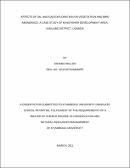| dc.description.abstract | Uganda discovered commercially viable deposits of petroleum in 2006. However, most of these areas where petroleum was discovered are considered to be centers for “biodiversity hotspot” and Kingfisher Development Area is among. Oil development has a potential of destroying these ecosystems and the species inhabiting those areas if not well planned and controlled. The research aimed at assessing the effects of Oil and Gas Exploration on vegetation and bird abundance in Kingfisher. The study objectives were; To determine the spatial and temporal trends in Land Use and Land Cover changes from 1990 to 2019, To determine the effects of oil and gas exploration on vegetation relative abundance; To determine the effects of oil and gas exploration on bird abundance. Remotely sensed methods were used to determine the spatial and temporal changes in Land Use and Land Cover using Satellite images of 1990, 2010, 2014 and 2019. The study used observation and survey methods for data collection on vegetation and bird abundance. Vegetation relative abundance and diversity was determined by observing, counting and recording plants using a (1x1)M, (3x3)M and (5x5)M quadrats along a 50M line transect for both oil pads and control areas. The study determined bird abundance by walking, observing and listening to sounds along a 1 km line transect within a distance of 200m on either side of each transect. A binocular and an experienced local ornithologist were used. Seasonal variations were also put into consideration. Results showed a slight change in the spatial and temporal variations in the classified images in land use and land cover changes from the year 1990 to 2019 highlighting some land uses that have experienced a minimal change over the years. These equate to the total land cover loss to (6.29%) in forest area, (7.66%) in bushland, (4.13%) in farmland, (4.46%) wetlands, open water (0.32%) 17.4% in grassland and 5.46% built-up areas. The study identified thirty-five plant species and among these; three were recorded in oil pads, six in control areas and twenty-six were recorded in both oil pads and control areas. The study recorded the mean vegetation diversity of (1.92±0.06) in oil pads and (1.82±0.08) in control areas. Results showed no significant difference in mean vegetation relative abundance for both oil pads and control areas at P<0.05. The study encountered twenty-five different bird species and the results revealed that there is no significant difference between the mean number of bird species recorded in oil pads and the ones recorded in control areas at P<0.05. Findings also showed that mean number of bird species observed in both oil pads and control areas for wet season significantly differed from that of dry season at P < 0.05. The mean number of bird species recorded in the oil pads and control areas during wet season was not significantly different at P<0.05. It is therefore important to note that oil and gas exploration is not a significant contributor to land use and land cover change in the area. However, there are other factors like overgrazing, fuel wood collection, agriculture, fishing to mention but a few that were observed as indicated in Appendices that could be contributing to this change. The study therefore recommends that Ministry of Energy and Mineral Development, National Environmental Management Authority to continue ensuring that oil companies and other stakeholders follow the guidelines put in their Environmental and Social Impact Assessment reports and project briefs for biodiversity protection and conservation. The study also recommends that local authorities should work together to ensure that the activities taking place in the protected areas are regulated or prohibited. | en_US |

